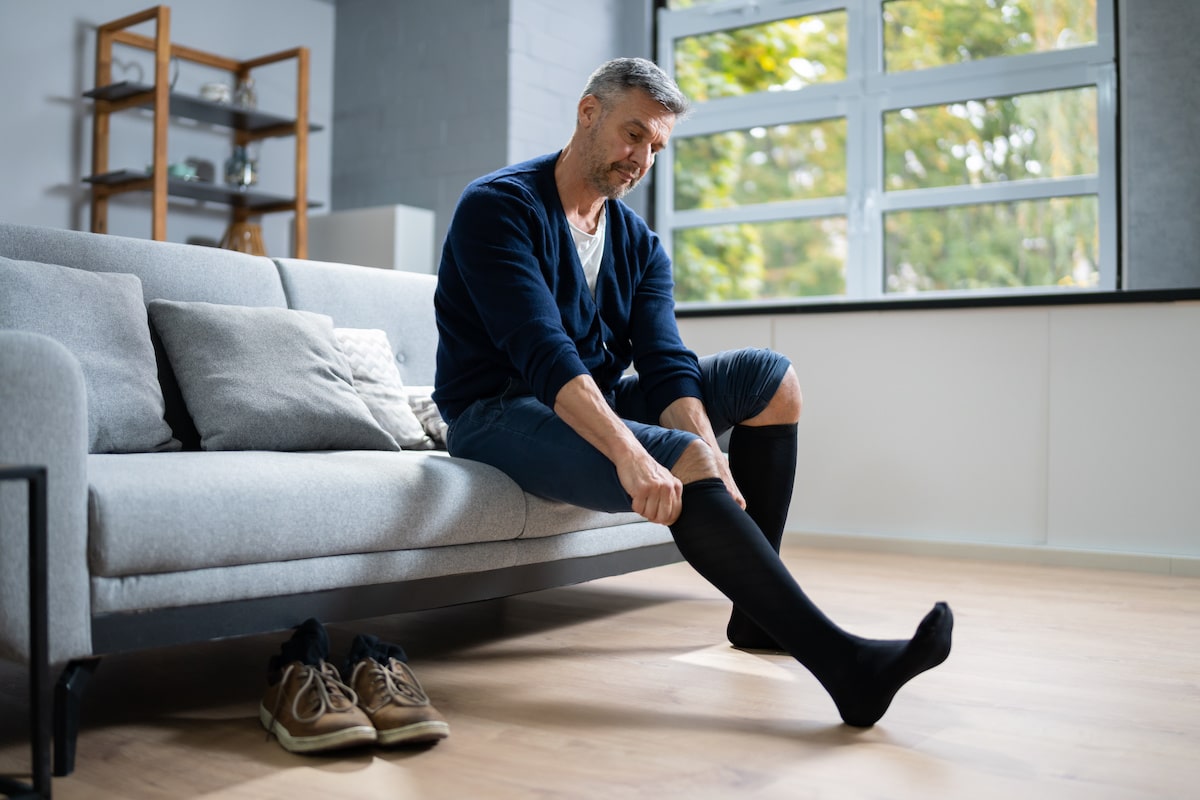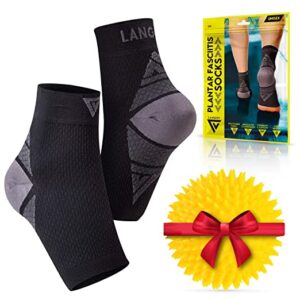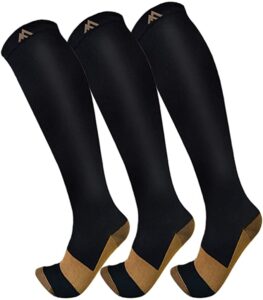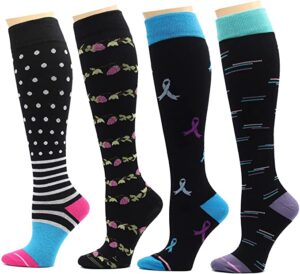All You Need to Know About Compression Socks for Neuropathy
Peripheral neuropathy seriously affects the feet, whether caused by diabetes, chemotherapy, or other factors. Symptoms such as pins and needles, numbness, painful cramps, burning, or tingling sensations are sometimes unbearable.
Treatments for neuropathy are numerous, and their efficiency depends on the individual. Many sufferers find relief in home remedies like topical creams, massages, TENS, light therapy, and others when pharmaceutical treatments fail.
Compression socks for neuropathy can also be a huge help. Compression therapy boosts blood circulation, reduces pain, and improves stability.
But wearing compression socks is not always recommended if you have peripheral neuropathy, especially if you also suffer from peripheral artery disease, another common diabetes complication.
So, why and when should you use compression socks for neuropathy?

Table of Contents
What is Peripheral Neuropathy?
Peripheral neuropathy – also called distal symmetric peripheral neuropathy – affects the peripheral nervous system from the lower limbs, feet, legs, and sometimes the hands and arms. It is mainly caused by diabetes, chemotherapy treatments, exposure to toxins, and other factors.
Diabetes and high blood sugar levels weaken the small vessels that bring oxygen and nutrients to the nerves of your body’s extremities. Once damaged, the nerves’ ability to send signals to the brain is disrupted. It can cause significant pain and various symptoms such as numbness, loss of feeling, tingling, prickling, or burning sensations, sharp cramps, muscle weakness, loss of balance, and more.
Peripheral neuropathy may affect up to 50% of people with diabetes, and the pain it causes is most commonly called “diabetic foot pain. “ Complications frequently lead to foot ulcers, gangrene, and lower limb amputations.
Related article: The 10 Best Shoes for Neuropathy in 2022
Do Compression Socks Help with Neuropathy?
Compression socks and stockings work by temporarily compressing the limbs to contract dilated veins. They increase blood flow and may relieve pain and discomforts caused by peripheral neuropathy and nerve damage.
Compression therapy is also proven to improve balance and stability, helping with some foot ulcers. Here are five benefits of compression socks for neuropathy, backed up by science:
Boost blood circulation
The very first purpose of compression therapy is to improve blood circulation and vascular function. People suffering from diabetic peripheral neuropathy often have poorer blood flow and may need compression socks to help send blood back up to the heart.
Circulatory issues among people with diabetes may have different causes. If you have been diagnosed with Peripheral Artery Disease (PAD), another common diabetes complication, you should not wear compression stockings. PAD reduces blood flow from the heart to the lower limbs, while compression socks are designed to boost blood circulation from the lower limbs back up to the core. If you have peripheral neuropathy, always ask for your doctor’s advice before wearing compression socks.
Improve stability and balance
Compression stockings have proven to improve stability and balance while decreasing postural sway significantly.
Reduce foot swelling
Swollen feet, also referred to as peripheral edema, are very common, and there’s a clear relationship between diabetes and swelling in the lower limbs. Swelling may be a sign of peripheral neuropathy and poor blood circulation, leading to fluid building up in the feet.
Compression therapy is a very effective treatment for swollen feet, ankles, and legs. Helping blood circulate back to the heart avoids fluid build-up in the lower legs and decreases swelling. Research backs up the benefits of wearing mild graduated compression socks for diabetic patients with swollen feet.
It May help with diabetic foot ulcers.
A foot ulcer is a severe foot complication often caused by diabetes. When you have diabetic peripheral neuropathy, you may lose feeling in your feet. It may cause minor wounds to stay unnoticed. Besides, poor blood circulation associated with your condition considerably slows down the natural healing process of your body. These unseen wounds can quickly get infected and cause foot ulcers.
Research has found that compression therapy may help with some specific forms of foot ulcers. Diabetic foot ulcers can lead to severe complications such as gangrene and amputations in the worst cases. Always ask for your doctor’s advice first.
Lower neuropathy pain and numbness
By improving blood circulation in the lower limbs, compression therapy helps bring more oxygen and nutrients to the blood vessels and the nerves of our body’s lower extremities. It helps reduce the pain, numbness, and other discomforts caused by peripheral neuropathy while decreasing the risks of further harm to your nerves.
Patients with neuropathy have reported that wearing compression socks have significantly helped relieve the “pins and needles” feeling.
Related article: 10 Great Neuropathy Creams for Topical Pain Relief
5 Great Compression Socks for Neuropathy
I insist that if you have peripheral neuropathy from diabetes, chemotherapy, or any other factor, you must ask for your doctor’s advice before wearing compression socks. While compression therapy may ease pain and symptoms for some, it may also worsen others’ conditions.
Once your doctor has given you the all-clear for compression socks, here are the five best choices for people living with peripheral neuropathy:
1. OrthoSleeve Neuropathy Light Gradient Compression Socks

Orthosleeve Wellness socks for diabetic neuropathy provide light gradient compression on the feet and ankles. They’re ideal for people who need a little extra support to improve balance and stability while walking. Light medical-grade compression therapy helps relieve minor swelling, mild neuropathy foot pain, and tired and achy feet.
They’re anatomically designed for the right and left foot and feature shaped toe and heel pockets for enhanced foot placement. The contour of the foot is padded for comfort and sock durability. The interior is very soft and seamless.
These socks are made with nano-bamboo charcoal fabric. It’s moisture-wicking, anti-bacterial, breathable, and super soft. They’re also infused with silver ions to promote fresh and healthy feet.
2. Powerlix Knee-High 20-30 mmHg Compression Stockings

This option is excellent for those looking for over-the-counter strong compression socks. They provide a 20 – 30 mmHg level of graduated pressure on your feet and lower legs. They’re ideal for neuropathy sufferers who need firmly supportive socks to relieve moderate to severe foot pain or swelling.
Powerex compression socks have been designed to aid people suffering from swollen feet, plantar fasciitis pain, tired legs, circulation issues, and peripheral neuropathy.
They leave no mark on your skin and have an anti-slip system at the top band that keeps them up all day. The material is soft, breathable, lightweight, and moisture-wicking. Last but not least, Powerlix offers a 1-year replacement guarantee.
3. Langov Open Toe Neuropathy Compression Foot Sleeves

This open-toe design from Langov is also an excellent option for people with neuropathy. The advantage of wearing open-toe compression socks are numerous.
Toeless socks allow people with sweaty feet to keep their toes away from excessive sweat. Compression socks tend to exacerbate sweating, so these socks might be a good option if you suffer from sweaty feet or fungus infections between the toes.
An open-toe design may also be more suitable for people with large toes or toes with deformities like hammertoes or bunions. Neuropathy can cause toe deformities. If it’s your case, you’ll probably have difficulties inserting your feet into regular compression socks, and the pressure might be too intense on your toes. Wearing toeless compression socks will probably feel better.
This option from Langov is excellent. It provides a strong compression level of 20 – 30 mmHg, ideal for those with moderate to severe edema, mild neuropathy, and pain. They’re so thin and lightweight that you can wear them with any of your regular shoes.
The cuff is non-slipping and so stretchable that it perfectly adjusts to the shape of your foot and ankle. The fabric is top-quality, with excellent moisture-wicking properties and incredible softness! Besides, the package includes a massage ball for the feet!
4. Fuel Me Foot Copper Moderate Compression Socks

With over 35,000 reviews on Amazon, these compression socks from Fuel Me Foot are a best-seller. They’re also great if you have neuropathy from chemotherapy or diabetes. They provide compression of 15 – 20 mmHg, ideal for those who need to boost circulation, decrease swelling, or ease the pain.
They’re made for daily wear and are super protective for sensitive skin. The non-slip cuff stays in place without constricting your leg. They have reinforced heels and toes to prevent blisters and provide comfortable cushioning.
These socks are made in a great moisture-wicking and breathable fabric infused with copper. Copper socks are great for neuropathy as the material is anti-bacterial and helps keep the feet healthy, fungus-free, and odor-free.
5. Dr. Motion Therapeutic Graduated Mild Compression Socks for Women

Dr. Motion’s compression socks are another popular product. This model is for women, but you can find similar ones for men. The compression is mild and aims to promote blood circulation, alleviate minor pains and discomfort, reduce leg fatigue, and decrease gentle foot and leg swelling.
The compression is graduated. It increases down towards the ankle. They are incredibly comfortable to wear and provide support daily to improve foot stability.
The top band is non-binding, so it does not leave any nasty marks on your skin. The interior construction is entirely seamless to prevent blisters and anti-bacterial material. It’s an excellent choice for women with neuropathy looking for mild compression socks.
Related article: The Best Foot Massagers for Neuropathy and Diabetic Foot Pain
How to Choose Compression Socks?
If you have diabetic neuropathy, you should choose your compression socks carefully. The most important things to look at are the compression level, the length of the socks, their comfort and protective features, and the fit. In any case, ask for your doctor’s recommendations before purchasing compression socks. Depending on the neuropathy symptoms you suffer from, you might need something more specific that requires a medical prescription.
Compression level and socks’ length
Compression socks are available in four compression levels. The strength is measured in millimeters of mercury (mmHg). Your doctor must decide the compression strength you need.
- 8 – 15 mmHg. It’s the lowest compression level. It provides light pressure on your legs and feet to boost blood circulation and decrease minor swelling. It’s useful to relived leg fatigue and pain caused by mild neuropathy symptoms. This level of compression might also be enough to improve balance and stability.
- 15 – 20 mmHg provides moderate compression. It’s the compression level generally used for in-flight socks. It boosts blood circulation and helps lower mild swelling in the feet and legs. Medium compression socks lower the risk of deep vein thrombosis. They can also help relieve pain and discomfort caused by damaged nerves.
- 20 – 30 mmHg provides a muscular pressure strength. It’s made to help prevent and relieve severe varicose veins and treat moderate to severe peripheral edema (foot or leg swelling). It’s also used to manage some active ulcers, as it may relieve moderate to severe neuropathy pain and symptoms.
- 30 – 40 mmHg compression socks are only available under medical prescription. It’s the most substantial compression level designed to treat severe medical conditions.
Compression socks for neuropathy are commonly available in knee-high, thigh-high, and waist-high lengths. Depending on your condition, your doctor will advise you on what size is best for you.
Protection and comfort
Socks for neuropathy must provide your feet with extra comfort and protective features. Peripheral neuropathy significantly fragilizes your feet and makes them prone to numerous complications.
When buying compression socks, ensure they have a non-binding top band that leaves no nasty marks on your legs. Choose pairs with a seamless interior design to prevent the fabric from rubbing on your feet and causing skin irritations, blisters, or calluses.
Your socks’ material is essential and can make a difference. Choose moisture-wicking and anti-bacterial yarns that keep your feet in a dry and healthy environment. This will help keep fungus and bacteria at bay.
Extra padding around sensitive areas of the foot, like the heels and toes, is also a good option. It enhances comfort and provides better impact protection.
You may have noticed neuropathy socks are often white. If you’ve lost sensitivity in the feet because of nerve damage, white yarn makes it easier to detect bloodstains from wounds that you may not feel.
Proper fit
Proper fit is one of the most important things to look for when buying compression stockings, especially if you have neuropathy. Socks that are too tight may have the opposite effect and block your blood circulation instead of improving it. On the contrary, if your compression socks are too loose, they will sag and rub on your skin. You might need to try different pairs before finding the one that perfectly fits you.
Compression Therapy and Diabetic Neuropathy
Compression socks are not always suitable for people with diabetes with neuropathy. They may even be contra-indicated in some cases. Here’s a bit more information about compression therapy for diabetic neuropathy.
Do compression socks help with numbness or tingling?
Compression socks can ease most pain and symptoms caused by nerve damage by improving the circulation in your feet and lower legs. Whether worn by pregnant women, diabetics with neuropathy, people with varicose veins, or other foot conditions, compression socks may help reduce numbness, tingling, or burning feet sensation.
Neuropathy is a challenging condition to address. It affects the nervous system and disrupts the pain signals sent to the brain. Both the symptoms and their treatment depend on the individual. It would be best if you tried it yourself (with your doctor’s supervision).
Can compression socks make neuropathy worse?
Compression socks may help with neuropathy but may also worsen symptoms if you have other related conditions, such as peripheral vascular disease, peripheral artery disease (PAD), or other ischemic diseases.
Compression therapy boosts blood circulation from the lower legs back up to the heart. When you have PAD, your blood does not reach the lower limbs properly, and you need the opposite circulation-boosting process. In other words, you would need something to help blood circulate from the heart down to the feet. Wearing compression socks when you have peripheral artery disease can be dangerous.
Wearing compression socks for too tight or loose neuropathy may also worsen neuropathy symptoms. They may cause wounds, blisters, or irritations that can become diabetic foot ulcers. You must take precautions before wearing compression socks and ask for your doctor’s advice and recommendations first.
Even if this is not a frequent scenario, a 2007 study reported that misusing elastic compression stockings may cause peripheral nerve damage.
Compression socks common side effects
Besides the above risks specific to neuropathy, wearing compression socks can also cause common side effects such as irritation, redness, skin breaks, or bruises.
If you notice anything unusual on your skin, pain, or discomfort while wearing compression socks, immediately take them off and seek your doctor’s medical attention.
So, should I wear compression socks with neuropathy?
The bottom line is unclear, and it depends on your situation. Some people with neuropathy will benefit significantly from compression therapy, while others may see their symptoms worsen.
If you’ve been prescribed compression socks, make sure the ones you’re buying are neuropathy-friendly. They must be non-binding at the top, have a soft and seamless interior design, be moisture-wicking, and provide enhanced comfort. Proper fit is essential too. You may need to try several pairs before finding the perfect fit.
You should not wear compression socks if you have peripheral artery disease or other ischemic diseases.
Always ask for your doctor’s advice before wearing compression socks for neuropathy.